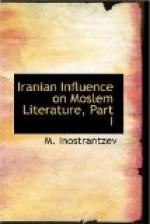“The first definite mention of the Masmoghan occurs in the year 131 A.H., in which Abu Muslim called upon the former to surrender and as he declined despatched Musa Ibn Kaab against him who however failed to effect anything against him. (Ibn al Athir vol. 5,304). It was only under Mamun that the mountainous country of the Masmoghan was subjugated. The last prince, whose brother Aparwez fought on side of the Arabs, was taken prisoner and confined with his two daughters in the mountain fastness of Ustunawand in 141 A.H. (Tabari Vol. 2, 137).
“The exact time of the rise of this principality is unknown. For the Masmoghan Mardanshah who is mentioned by Saif in a treaty with Suwaid Mukarrin under Omar (Tabari 1, 2656), belongs positively to the time of Muhallab, 98 A.H. I surmise, however, that the Dynasty of the Magian Baw, the father of the renegade Mahgundat, whose Christian name was Anstasious, who became a martyr to Christianity in 628, originated from the village of Warznin in the territory of Rai (Acta Anstasii Persae, p. 26 & 56), and is connected with the Bawend dynasty which appeared just at this place in 167, and is definitely traced to the Magian Baw. (The authorities for the above are Tabari vol. 3, 1295 and Zahirud-din 205, see also ZDMG 49, 661.)
“Baw is a pure Magian name and is a transcription of the Avesta Bangha (Yesht 13,124). Another transliteration of the same word is Bohak, a name borne by a hero of Ispahan who with his six sons and an army joined Ardeshir (Karnamak 4, 3, p. 22-19; Neoleke 46). It was also the name of a son of Hobakht, the chief Mobed under Shapur II. Bahak, son of Fredon, was the ancestor of Aturpat Mahraspand (Bundahesh 33; West Pahlavi Texts 1, 145). Another form of the same name is B[=a]we, who was the Astabed or magister officiorum of the Persians (Josua Stylite ed. Wright 59). The first ruler of the Bawend dynasty who enters history is Sharwin ibn Surkhab (Tabari 3, 519). By the Arabs he was at first made a vassal controlling the slopes of the Alburz (Ibn al Faqih 304; Yakut 3, 283), and probably assumed the title Padashkhwargar-shah which his descendants continued to hold in the time of al Beruni (Chronology, p. XL, No. 7). In Yakubi (vol. 2, 479) he even bears the title of King of Tokharistaxi. After him is named Mount Sherwin on the boundary of Komish (Tabari 3, 1275; Ibn al Fakih 305; Belazuri 339, 7). In the year 201, that is, A.D. 816-17, however, the governor of Tabaristan, Abdallah Ibn Khurdadbeh, the father of the historian and geographer, invaded Larijan and Sarijan and annexed them to the empire of Islam. He likewise conquered the mountain land of Tabaristan and compelled Shahryar, the son of Sherwin, to surrender (Tabari 3, 1014).
“But after the death of Shahryar, in 825-26, Maziyar Ibn Qaren contested the kingdom with his son Shapur and in alliance with the Moslems invaded Mount Sherwin, captured the sons of Shahryar and put them to death. (Tabari 3, 1093, Belazuri 339 and Ibn al Fakih 309.) However, a son of Shahryar named Qaren who had been detained at the court of Maziyar later on joined the Arabs and after the fall of Maziyar was restored to his paternal estate.




